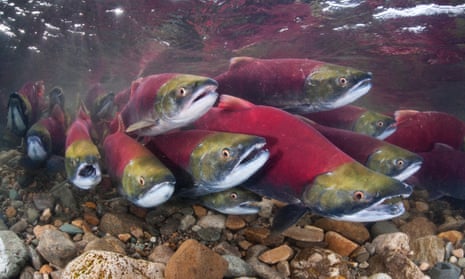Populations of migratory river fish around the world have plunged by a “catastrophic” 76% since 1970, an analysis has found.
The fall was even greater in Europe at 93%, and for some groups of fish, with sturgeon and eel populations both down by more than 90%.
Species such as salmon, trout and giant catfish are vital not just to the rivers and lakes in which they breed or feed but to entire ecosystems. By swimming upstream, they transport nutrients from the oceans and provide food for many land animals, including bears, wolves and birds of prey.
The migratory fish are also critical for the food security and livelihoods of millions of people around the world, while recreational fishing is worth billions of dollars a year. The causes of the decline are the hundreds of thousands of dams around the world, overfishing, the climate crisis and water pollution.
The scientists said the situation may be even bleaker than it seemed, as many declines began before 1970. Populations of sturgeon in the Great Lakes of North America, for example, have dropped by 95% from historic levels. Furthermore, suitable data has not been gathered on species in some of the world’s most biodiverse rivers such as the Mekong, Congo, Amazon and Yangtze, where researchers fear there will be hundreds of fish extinctions in the coming decades.
The average fall in populations was 84% in Latin America, while there has been a 59% decrease in Asia-Oceania, although there is limited data there and not enough from Africa to determine any reliable trend. In North America, the fall was less dramatic, at 28%. This is probably because large declines occurred before 1970, but also as a result of a growing number of dams being removed.
“For migratory fish, there’s nothing worse than a dam,” said Zeb Hogan, at the University of Nevada and an author of the new report. He said the good news was that fish could return quickly: “Almost without exception, where dams have been removed, you see populations bounce back, often much more quickly than anyone anticipated.”
A river restoration completed by the Penobscot River Restoration Trust partners in 2016 on the Penobscot River in Maine, US, led to river herring numbers growing from a few hundred to nearly 2m a year. The Dam Removal Europe coalition is working to free the continent’s rivers from more than 100,000 obsolete barriers. But thousands of hydropower dams are being built in other parts of the world.
“Catastrophic losses in migratory fish populations show we cannot continue destroying our rivers,” said Arjan Berkhuysen, at the World Fish Migration Foundation. “This has immense consequences for people and nature across the globe. We can and need to act now before these keystone species are lost for good.”
Michelle Jackson, at the University of Oxford, UK, who was not involved in the report, said: “The population declines are certainly very drastic, but I am not surprised. The outlook gets worse each time [there is a new report].”
She said migratory fish were often the driving force in food chains because they transport nutrients: “If these fish populations continue to decline, there will be far-reaching consequences for many species which rely on them.”
The decline in migratory fish populations is higher than that for land and ocean animals, whose populations have fallen by an average of 60% in the last 50 years. “Freshwaters are disproportionately at risk to human pressures, since they are affected by everything happening in the surrounding catchment,” said Jackson.
Previous research by Hogan found many giant river fish are on the verge of extinction, with populations from catfish to stingrays down by 97% since 1970. Other studies have shown only a third of world’s great rivers remain free-flowing, while in Britain, for example, 97% of the river network has been interrupted by human-built structures.
The report, led by Stefanie Deinet at the Zoological Society of London, examined data from 1,406 populations of 247 species. There are 1,100 species that must migrate to survive. The researchers said much more data was needed for regions outside Europe and North America to go beyond the general trends presented in the report.
The analysis did show management plans for rivers and fishing helped curb the losses, with populations down 54% in such circumstances, compared with 87% for those that were unmanaged.
Migratory fish often use water temperature as a cue to start their journeys, but dams can significantly lower the temperature of river water. Global heating is also a factor, and can also change rainfall patterns. “So you get these very unnatural flows that can really have an impact on migratory fish,” said Hogan.
“Not all dams are created equal,” he added. “Some dams are more environmentally damaging than others and how you place, design and operate them is important.” The damage to ecosystems and livelihoods must be taken more into account when building new dams, he said.
Stephanie Januchowski-Hartley, at Swansea University, UK, said the millions of small obstructions to rivers, such as road culverts, also needed to be considered: “The cumulative effects of those are potentially greater than that of larger infrastructure, because of sheer numbers in the waterscape.”
“We know why we’re losing these fish and we know what to do to save or restore them,” Hogan said. “It’s now a matter of public awareness and public will.” Stuart Orr, at WWF, said: “The world needs to implement an emergency recovery plan for the benefit of people and nature.”
